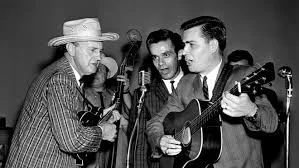Known as the “Father of Bluegrass Music,” Bill Monroe (1911–1996) played a foundational role in shaping and popularizing one of America’s most distinctive musical traditions. Born in Rosine, Kentucky, Monroe was the youngest of eight children in a deeply musical family. His early exposure to music came from multiple sources: his mother played fiddle and sang, his father was a step dancer, and his older siblings all played instruments. Church singing and rural revival meetings also influenced him, instilling in him a deep appreciation for vocal harmony.
Monroe began learning guitar as a child but eventually gravitated toward the mandolin, which would become his signature instrument. A mandolin is a small, stringed instrument. It typically has eight strings arranged in four pairs (called "courses") and is usually played with a pick, producing a bright, percussive tone that is well-suited for fast melodies and rhythmic strumming. He frequently performed with his Uncle Pen Vandiver, a respected local fiddler whose repertoire of traditional dance tunes left a lasting mark on Monroe’s musical vocabulary. Equally influential was Arnold Schultz, a Black guitarist and fiddler from western Kentucky. Schultz introduced Monroe to blues-inflected phrasing and complex thumb-and-finger picking techniques which Monroe would later integrate into the sound of bluegrass.
At eighteen, Monroe moved north to East Chicago, Indiana, joining his brothers Birch and Charlie, who worked at an oil refinery. The siblings played music together at night, and after Birch left the group, Bill and Charlie continued as a duo under the name the Monroe Brothers. With Charlie on guitar and lead vocals and Bill on mandolin and high harmony, they developed a distinctive style that blended Appalachian folk, Southern gospel, and hillbilly music. Between 1936 and 1938, the Monroe Brothers recorded more than sixty tracks for RCA Victor, building a devoted radio audience and laying the groundwork for the bluegrass sound Monroe would soon develop on his own.
After parting ways with his brother Charlie in 1938, a split marked by both personal and musical tensions, Bill Monroe set out to establish his own sound and artistic identity. The two had experienced considerable success as the Monroe Brothers, but creative differences, especially over musical direction and leadership, led to their breakup. Charlie quickly formed his own group, the Kentucky Pardners, and the siblings' rivalry became well known on the Southern radio circuit, with each trying to outdo the other in style, speed, and showmanship.
Determined to differentiate himself, Bill formed a new band: The Blue Grass Boys. The original lineup featured Cleo Davis (guitar), Art Wooten (fiddle), and Amos Garren (bass). In 1939, Monroe’s group auditioned for and secured a coveted spot on the Grand Ole Opry which dramatically expanded his national exposure. During this formative period, Monroe’s music blended traditional folk songs, gospel harmonies, hillbilly standards, and virtuosic instrumental breakdowns. While he rarely sang lead in these early years, his signature high tenor harmony became a defining element of the group’s vocal style, helping to shape what would soon be recognized as the blueprint for bluegrass.
Monroe’s style had already distinguished itself through fast tempos, tight vocal harmonies, and the percussive “chopping” rhythm of his mandolin. Though Monroe experimented with different band members and instruments in his early years, at one point even including an accordionist, the core lineup of between 1945 and 1948 became the blueprint for bluegrass instrumentation and performance. This legendary ensemble included:
Bill Monroe on mandolin and tenor vocals
Lester Flatt on guitar and lead vocals
Earl Scruggs on banjo
Robert “Chubby” Wise on fiddle
Cedric Rainwater (Howard Watts) on upright bass
Together, they introduced an entirely new sound to American music. Scruggs’s revolutionary three-finger banjo picking, Flatt’s smooth and confident lead singing, Monroe’s driving mandolin rhythms, and Wise’s melodic fiddle lines produced a virtuosic and high-energy ensemble that stood apart from other string bands of the time. Monroe was also a creative vocal harmonist, often preferring to sing the high tenor part above the lead vocalist, a technique that helped define the vocal sound of the genre.
During this time, the band made several landmark recordings for Columbia Records, including “Will You Be Loving Another Man?” (1946), with lead vocals by Flatt, and “Blue Yodel No. 4,” a tribute to Jimmie Rodgers. One of the group’s most famous early songs was “Blue Moon of Kentucky,” a waltz-time ballad written by Monroe that would later be famously covered by Elvis Presley. Their approach was so original and influential that the genre of bluegrass itself came to be named after Monroe’s band.
Although the departure of Flatt and Scruggs in 1948 marked the end of the classic lineup, Bill Monroe quickly reassembled the Blue Grass Boys and continued to perform on the Grand Ole Opry and tour across the country. Monroe remained a relentless champion of the music he helped create, and his influence was felt throughout the bluegrass revival of the 1960s and 1970s, when younger audiences rediscovered traditional American roots music.
Monroe was also a successful promoter. In addition to recording for Columbia Records, Monroe and his band were heard regularly on WSM radio and the Grand Ole Opry, and they toured extensively often performing in tent shows that Monroe himself organized in small towns and cities across the country.
Monroe continued performing with various lineups of the Blue Grass Boys until his death in 1996, and his impact on country, bluegrass, and American folk music remains immeasurable. In fact, nearly every significant early bluegrass artist was either a former Blue Grass Boy, worked with someone who was, or modeled their sound on Monroe’s group.

